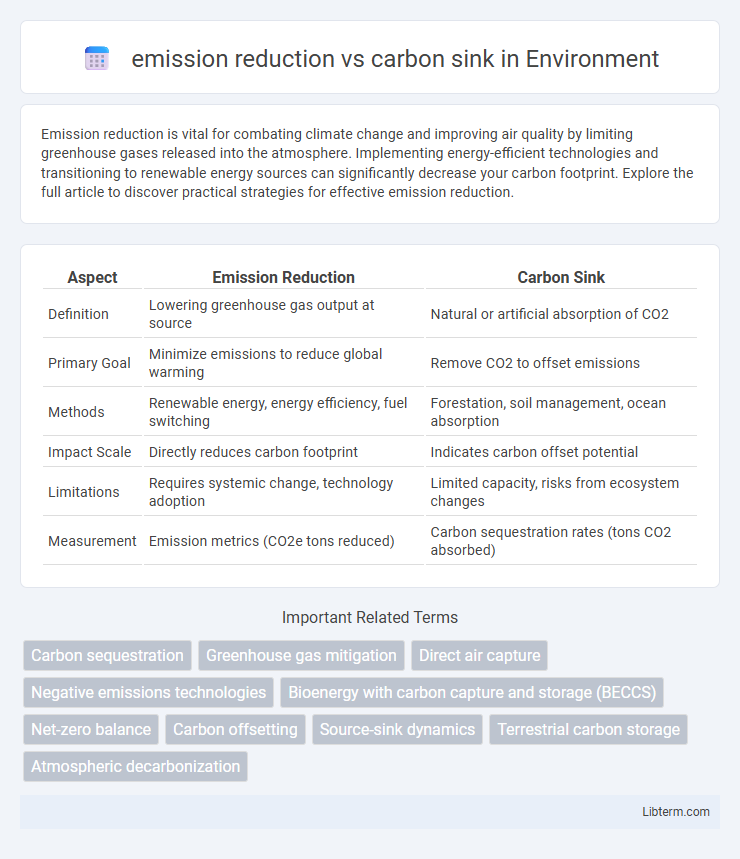Emission reduction is vital for combating climate change and improving air quality by limiting greenhouse gases released into the atmosphere. Implementing energy-efficient technologies and transitioning to renewable energy sources can significantly decrease your carbon footprint. Explore the full article to discover practical strategies for effective emission reduction.
Table of Comparison
| Aspect | Emission Reduction | Carbon Sink |
|---|---|---|
| Definition | Lowering greenhouse gas output at source | Natural or artificial absorption of CO2 |
| Primary Goal | Minimize emissions to reduce global warming | Remove CO2 to offset emissions |
| Methods | Renewable energy, energy efficiency, fuel switching | Forestation, soil management, ocean absorption |
| Impact Scale | Directly reduces carbon footprint | Indicates carbon offset potential |
| Limitations | Requires systemic change, technology adoption | Limited capacity, risks from ecosystem changes |
| Measurement | Emission metrics (CO2e tons reduced) | Carbon sequestration rates (tons CO2 absorbed) |
Understanding Emission Reduction and Carbon Sinks
Emission reduction involves limiting or cutting greenhouse gas emissions at their source, such as reducing fossil fuel use or enhancing energy efficiency, to mitigate climate change. Carbon sinks, including forests, oceans, and soil, naturally absorb and store carbon dioxide from the atmosphere, offsetting emissions and helping maintain ecological balance. Effective climate strategies integrate both emission reduction and carbon sink enhancement to achieve net-zero carbon goals and combat global warming.
Key Differences Between Emission Reduction and Carbon Sequestration
Emission reduction involves actively decreasing the amount of greenhouse gases released into the atmosphere through measures like energy efficiency, renewable energy, and industrial process improvements. Carbon sequestration, on the other hand, refers to capturing and storing carbon dioxide from the atmosphere in natural or artificial reservoirs such as forests, soil, or geological formations. The key difference lies in emission reduction preventing emissions at source, while carbon sequestration focuses on removing and storing existing carbon to mitigate climate change.
Why Emission Reduction Is Critical for Climate Goals
Emission reduction directly decreases the amount of greenhouse gases released into the atmosphere, limiting global warming and mitigating climate change impacts. While carbon sinks, such as forests and oceans, absorb CO2, their capacity is finite and vulnerable to degradation from environmental stressors. Prioritizing emission reduction ensures that the balance between carbon output and absorption remains manageable, making it indispensable for achieving international climate targets.
The Role of Carbon Sinks in Mitigating Climate Change
Carbon sinks, including forests, oceans, and soil, play a crucial role in mitigating climate change by absorbing approximately 30% of anthropogenic CO2 emissions annually. Effective enhancement and preservation of natural carbon sinks can significantly offset emission reduction efforts, reducing the atmospheric concentration of greenhouse gases. Strategies combining emission reduction with carbon sink management amplify climate mitigation outcomes, supporting global targets to limit temperature rise below 1.5degC.
Natural vs. Artificial Carbon Sinks: Effectiveness Compared
Natural carbon sinks, such as forests, wetlands, and oceans, absorb approximately 30% of global CO2 emissions annually, playing a crucial role in mitigating climate change. Artificial carbon sinks, including direct air capture and bioenergy with carbon capture and storage (BECCS), offer scalable and controlled CO2 removal but currently contribute less volume compared to natural sinks due to technological and economic limitations. Combining both natural and artificial sinks enhances overall carbon sequestration effectiveness, balancing ecosystem preservation with innovative technological solutions for emission reduction.
Emission Reduction Strategies: Technology and Policy Approaches
Emission reduction strategies prioritize cutting greenhouse gas emissions at their source through advanced technologies like renewable energy systems, carbon capture and storage, and energy efficiency improvements. Policy approaches such as carbon pricing, emissions trading schemes, and regulatory standards create economic incentives and frameworks that drive industrial and consumer transitions toward lower carbon footprints. Integrating technology and policy enhances the effectiveness of emission reductions, differentiating these proactive measures from carbon sinks that passively absorb atmospheric CO2.
Enhancing Carbon Sinks: Forests, Oceans, and Soil Solutions
Enhancing carbon sinks plays a crucial role in balancing global carbon emissions by increasing the natural absorption and storage of CO2 in forests, oceans, and soils. Forests sequester approximately 30% of anthropogenic carbon emissions through photosynthesis, while oceans absorb about 25% of emitted CO2 via phytoplankton and carbonates. Soil carbon sequestration, achieved through regenerative agriculture and soil management practices, offers a scalable solution to trap carbon, improve soil health, and mitigate climate change impacts effectively.
Limitations and Challenges of Carbon Sinks
Carbon sinks face significant limitations and challenges, including saturation risks where their capacity to absorb CO2 diminishes over time, and vulnerability to climate change impacts like droughts and wildfires that can release stored carbon. Monitoring and verifying carbon sequestration accurately remains complex, hindering reliable accounting in carbon markets and policy frameworks. Furthermore, carbon sinks cannot fully replace emission reductions since they do not address the root cause of greenhouse gas emissions.
Synergies and Trade-Offs Between Emission Reduction and Carbon Sinks
Emission reduction strategies and carbon sinks work synergistically to mitigate climate change by lowering greenhouse gas concentrations and enhancing natural or engineered carbon capture. However, trade-offs arise when land-use changes for carbon sinks compete with agricultural productivity or biodiversity, potentially limiting emission reduction benefits. Balancing optimized emission cuts with sustainable carbon sink management maximizes climate mitigation outcomes while safeguarding ecological integrity.
Future Outlook: Combining Emission Reduction and Carbon Sink Solutions
Future climate strategies emphasize integrating emission reduction with carbon sink solutions to achieve net-zero targets by 2050. Innovations in afforestation, soil carbon sequestration, and blue carbon ecosystems complement aggressive cuts in fossil fuel use and industrial emissions. This dual approach enhances climate resilience, enabling more effective mitigation of global warming impacts.
emission reduction Infographic

 libterm.com
libterm.com